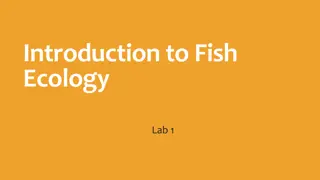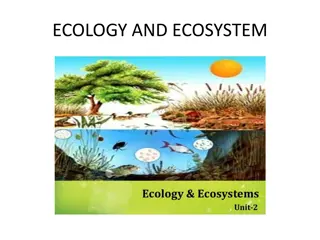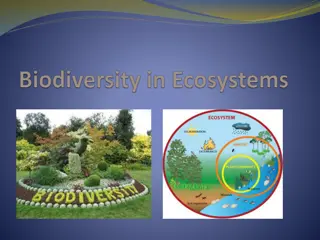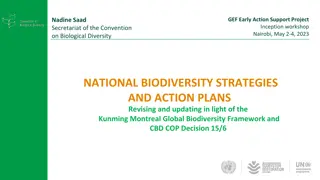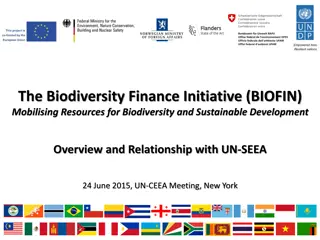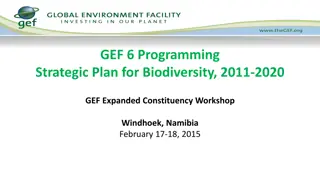Knowledge Management for Biodiversity
Join the KM4B Webinar Series to learn about knowledge management in the context of biodiversity, its protocols, and the importance of accessible data and information for effective biodiversity governance. Explore key initiatives and tools supporting the collection, curation, and sharing of biodivers
2 views • 25 slides
Understanding Ecology: Interactions Between Organisms and their Environment
Ecology is the scientific study of how living organisms interact with each other and their environment. It delves into the relationships between biotic and abiotic factors, encompassing topics such as the distribution and abundance of organisms, structural adaptations, behavior under natural conditi
2 views • 42 slides
Biodiversity Parks of Delhi: Oasis of Nature in the Urban Jungle
Delhi's Biodiversity Parks, including the Yamuna Biodiversity Park and Aravalli Biodiversity Park, are unique landscapes that serve as home to vanishing species, wetlands, grasslands, and medicinal herbs. These parks offer ecological, cultural, and educational benefits, representing a conservation s
4 views • 10 slides
Understanding Ecosystems: Ecological Interactions and Dependencies
Ecology is the study of how organisms interact with their environment, influencing their distribution and abundance. This exploration covers terrestrial and aquatic biomes, energy flow, environmental impacts, adaptations, and global ecosystems, emphasizing the interconnectedness of all living organi
2 views • 58 slides
Wild Coast N2 Biodiversity Offset Project Overview
In 2014, SANRAL initiated the N2 Wild Coast Biodiversity Offset project to conserve biodiversity in selected sites along the Wild Coast region. The project aims to protect and promote the unique biodiversity of these areas without introducing new species or disrupting local communities. Through acti
0 views • 11 slides
Understanding Fish Ecology: Interactions, Diversity, and Environmental Factors
Fish ecology involves studying the distribution, interactions, and abundance of fish species in different ecosystems. This lab delves into the divisions of ecology, fish species diversity in marine and freshwater ecosystems, and the environmental factors affecting fish diversity and abundance. Disco
1 views • 7 slides
Understanding Ecology and Ecosystem: A Comprehensive Overview
Ecology, derived from the Greek word "oikologie," explores the interactions between organisms and their environment. The study encompasses various branches like human ecology, population ecology, and habitat ecology, focusing on the relationships within ecosystems. An ecosystem, defined by A.G. Tans
1 views • 68 slides
Understanding Biodiversity and Conservation: Importance and Key Concepts
Biodiversity is the variety of life on Earth, encompassing all species and ecosystems. Conservation efforts are crucial to preserve genetic, species, and ecological diversity. The values of biodiversity range from productive and economic to social and aesthetic. Maintaining a balance in ecosystems,
4 views • 17 slides
Importance of Biodiversity and Sustainability in Ecosystems
Biodiversity, the richness of life in genes, species, and ecosystems, plays a crucial role in sustaining the health of our planet and its inhabitants. It provides essential resources such as food, medicine, and economic benefits. Sustainability, the ability of ecosystems to maintain their structure
1 views • 6 slides
Understanding Media Ecology: Impact of Communication Technology
Media ecology is a theoretical concept analyzing the influence of media and communication technology on human culture. Neil Postman, a prominent figure in the field, delves into how communication media affect human perception, understanding, and values. This study views media as environments shaping
4 views • 23 slides
Principles of Ecology: Understanding Organism-Environment Interactions
Ecology is the scientific study of how living organisms interact with each other and their environment. It involves understanding organisms at their native habitats, from individuals to ecosystems. The discipline encompasses various branches and focuses on the relationships shaping the distribution
1 views • 14 slides
Shared Challenges in Biodiversity Informatics Collaboration
The Coalition of Open Biodiversity Infrastructures and Networks aims to enhance collaboration for comprehensive biodiversity data management and accessibility. They focus on delivering biodiversity knowledge effectively, enabling stakeholder participation, promoting open data sharing, mobilizing his
2 views • 13 slides
National Biodiversity Strategies and Action Plans in Light of COP Decisions
National Biodiversity Strategies and Action Plans (NBSAP) play a crucial role in implementing the Convention on Biological Diversity. This involves developing strategies, integrating biodiversity into various sectors, and engaging stakeholders for effective implementation. Various COP decisions emph
0 views • 15 slides
Strengthening Biodiversity Data Management in Togo
This project in Togo aims to strengthen biodiversity data management by modernizing the National Herbarium, digitizing records, and collaborating with GBIF partners. The program, funded by the European Union, focuses on capacity enhancement, data publication, and establishing a national network of d
0 views • 7 slides
Understanding Ecology: Ecosystems, Biodiversity, and Energy Flow
Explore the intricate world of ecology through topics such as ecosystems, biodiversity, energy flow, and nutrient cycling. Delve into the concept of niches, biodiversity levels, and the importance of energy flow and materials cycling in sustaining ecosystems. Learn about the nitrogen and carbon cycl
1 views • 18 slides
GEF Funding for Enabling Activities and Support to Biodiversity
GEF provides financial support for enabling activities related to biodiversity and climate change, with a focus on funding national strategies, action plans, and reports. The support includes access to funds for implementing enabling activities and engaging with international conventions. Countries
1 views • 14 slides
Understanding Ecology: Interactions and Environments in Biology
Ecology is the study of interactions between living organisms and their environment. It involves levels of research such as animal ecology, plant ecology, and more, while also exploring the biosphere's impact, biogeography, species distribution patterns, and energy sources like sunlight. Ocean upwel
1 views • 80 slides
Dimensions of Biodiversity - Exploring Earth's Diverse Ecosystems
The Dimensions of Biodiversity initiative, starting with a 10-year campaign, aims to characterize the genetic, functional, and ecological diversity on Earth through innovative research approaches. Funded projects include studies on tree communities, gut microbiota of bees, vulnerability of biodivers
0 views • 10 slides
The Impact of Invasive Species on Biodiversity and Ecosystems
The introduction of foreign species can have detrimental effects on biodiversity, ecosystems, and even humans. Invasive species like the Sea Lamprey and Burmese Python disrupt natural habitats, leading to a decline in biodiversity and posing risks to native species and human populations. However, th
0 views • 13 slides
Comprehensive Ecology Unit for Middle School Students
Engage 7th & 8th grade students in a 14-week ecology unit covering topics like levels of organization, population ecology, symbiosis, biodiversity, human impacts, and more. Utilize digital notebooks, interactive activities, and exploration tools to enhance learning and understanding. Access resource
0 views • 18 slides
Understanding Population Dynamics and Biodiversity Loss
The content discusses the importance of biodiversity for ecosystem function, causes of biodiversity loss, factors affecting declining biodiversity, and strategies for managing populations and ecosystems to restore biodiversity. It covers topics such as population growth rates, habitat loss, climate
0 views • 39 slides
Overview of The Biodiversity Finance Initiative (BIOFIN)
The Biodiversity Finance Initiative (BIOFIN) was developed in response to CBD COP-10 and aims to address the gap in biodiversity finance by supporting countries in mobilizing resources to implement National Biodiversity Strategies and Action Plans (NBSAPs). With funding from various sources, BIOFIN
1 views • 20 slides
Understanding Ecology and Biodiversity
Ecology explores the dynamic interactions between living (biotic) and non-living (abiotic) factors in ecosystems. It delves into selective breeding, protein structure, hormones, placenta function, and the vulnerability of embryos during early development. Meiosis, mRNA translation, feedback mechanis
0 views • 25 slides
Post-COVID Economic Recovery Aligned with Global Biodiversity Goals
Global economic recovery post-COVID presents a crucial opportunity to prioritize biodiversity alongside financial stimuli. Existing recovery packages lack explicit consideration for biodiversity, indicating the need for alignment with post-2020 global biodiversity frameworks to promote green recover
0 views • 7 slides
Influence of Income on Residential Yard Biodiversity in Baltimore
Residential yards in Baltimore, regardless of life stage, exhibit variations in biodiversity based on residents' income levels rather than other factors. The study explores how time and money influence plant diversity in yards, hypothesizing that residents with less money but more time will have hig
0 views • 25 slides
The Significance of Biodiversity in Ecosystems
Biodiversity plays a crucial role in boosting ecosystem productivity by ensuring each species contributes uniquely. Measuring biodiversity involves counting species in an area, with a higher species diversity indicating greater biodiversity. Despite this importance, an alarming number of species go
0 views • 17 slides
Introduction to Ecology and Environment Studies
Ecology is the study of the relationship between organisms and their environment, while the environment refers to the surroundings that influence living organisms. The biosphere is divided into the atmosphere, lithosphere, and hydrosphere. Terms in ecology include species, populations, communities,
0 views • 13 slides
Understanding Biodiversity: A Comprehensive Overview
Biodiversity, the variety of life on Earth, is a subject of fascination and importance for scientists and the general public alike. This content delves into the immense diversity of species, the levels of biodiversity (genetic, species, ecosystem), and the significance of preserving this rich tapest
0 views • 13 slides
Exploring Ecology: Interactions, Distribution, and Population Dynamics
Ecology delves into the relationships between organisms and their environment, understanding factors that limit species distribution, major interactions like competition and predation, as well as population growth patterns. This includes the influence of biotic and abiotic factors, ecological succes
0 views • 30 slides
Understanding Ecology: Key Concepts and Types Explained
Ecology, a vital branch of science, delves into the relationships between organisms and their environment. It encompasses biotic and abiotic factors, studying how living and non-living elements interact within ecosystems. Biotic components include living organisms like plants and animals, while abio
0 views • 7 slides
Importance of Biodiversity in Environmental Preservation
Understanding the significance of biodiversity is crucial for maintaining a healthy environment. Biodiversity encompasses the range of species and organisms within communities, playing a vital role in sustaining ecosystems and food sources. Loss of biodiversity can have detrimental effects on variou
0 views • 99 slides
Ecology and Ecosystem Concepts: Understanding Interrelationships in Nature
Ecology explores the interconnections between living organisms and their environment, dating back to zoologist Geoffroy St. Hilaire's early proposal in 1859. The term "ecology" originates from the Greek words for house and discourse, emphasizing the study of organisms within their habitat. Ecosystem
0 views • 36 slides
Exploring Ecology: Interactions and Environments
Dive into the world of ecology, where organisms interact and rely on each other and their surroundings. Understand the concepts of populations, communities, ecosystems, biomes, and the biosphere. Explore the vocabulary of ecology, from individual organisms to entire biomes. Learn about food chains,
0 views • 14 slides
Exploring the Intersection of Biodiversity and Climate Change Post-2020
The post-2020 global biodiversity framework delves into the crucial linkages between biodiversity and climate change, emphasizing the need for transformative changes and smart, scalable targets. It raises questions about the role of youth, politicians, and the business sector in biodiversity conserv
0 views • 8 slides
Understanding Ecology: Interactions in the Environment
Ecology, originating from the Greek words "Oikos" and "Logos," is the study of interactions between living and non-living components in the environment. It encompasses the relationships between plants, animals, microorganisms, and abiotic factors like light, water, nutrients, and atmosphere. Studyin
0 views • 16 slides
Exploring Green Thinking: Societal Perspectives on Environment and Ecology
Delve into the realm of green thinking through the eyes of social sciences in this lecture by Dr. Kate Nicholls at Auckland University of Technology. The discourse ranges from traditional Western views on nature to the rise of the green movement, including discussions on deep ecology, social ecology
0 views • 9 slides
Aichi Biodiversity Targets 2011-2020 Summary and Strategic Goals
The Aichi Biodiversity Targets outline strategic goals to address the underlying causes of biodiversity loss, reduce direct pressures on biodiversity, improve biodiversity status, enhance ecosystem services, and strengthen implementation. Targets include raising awareness, integrating biodiversity v
0 views • 5 slides
Biodiversity Mitigation in Victoria, Australia: A Case Study
Exploring the biodiversity offsetting system in Victoria, Australia, this case study focuses on the state's efforts to achieve Biodiversity Net Gain. The modules cover topics such as ecological vegetation classes, habitat condition scores, offset implementation, and the evolution of offsetting pract
0 views • 41 slides
Implications of GBF and White Paper on Financial Companies
The Global Biodiversity Framework (GBF) aims to address biodiversity loss and restore ecosystems through urgent action. Financial companies and businesses play a crucial role in the full implementation of the framework by providing adequate financial resources and technology transfer to developing c
0 views • 11 slides
Exploring Ownership of Biodiversity and Land for Better Environmental Policy
This project delves into the ownership of biodiversity and land, aiming to combine data on valuable land for biodiversity with economic data. By identifying actors influencing biodiversity, a new statistical module within environmental accounts in Sweden is to be developed. Utilizing geospatial info
0 views • 14 slides





